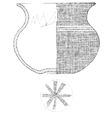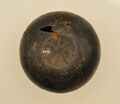NO·1 Castelletto sopra Ticino: Difference between revisions
No edit summary |
No edit summary |
||
| Line 26: | Line 26: | ||
}} | }} | ||
==Commentary== | ==Commentary== | ||
Images in {{bib|Gambari & Colonna 1988}}: 122, fig. 3 (drawing) and tav. 45 b (detail photo), {{bib|Gambari 1989b}}: 215, fig. 4 (photo), {{bib|Gambari 2004}}: 308, fig. 3 (photo), {{bib|Gambari 2018}}: 35, fig. 3 (photo). | Images in {{bib|Gambari & Colonna 1988}}: 122, fig. 3 (drawing) and tav. 45 b (detail photo), {{bib|Gambari 1989b}}: 215, fig. 4 (photo), {{bib|Gambari 2004}}: 308, fig. 3 (photo), {{bib|Gambari 2018}}: 35, fig. 3 (photo), {{bib|Stifter 2020}}: 31, fig. 20 (photo). | ||
Found in 1985 in the course of a rescue excavation in Via Aronzo (Cascina Baraggia, the site of the scuola materna) in the centre of [[Castelletto sopra Ticino|Castelletto Ticino]], in a grave belonging to a small Golaseccan necropolis. While the majority of the graves were unprotected and dated to G I C (7<sup>th</sup> c. BC), grave 5 in the centre is a cist grave constructed of local granite slabs with a complete inventory related to a male (see {{bib|Gambari & Colonna 1988}}: 120–126), which can be dated to the second quarter of 6<sup>th</sup> c. BC (late G II A). The globular beaker with outward-bent rim and concave foot was deposited inside the urn together with the ashes and the metal objects, and was thus probably a personal objects of the deceased ({{bib|Gambari & Colonna 1988}}: 120, 126). See also {{bib|Gambari 1989b}}: 215. | Found in 1985 in the course of a rescue excavation in Via Aronzo (Cascina Baraggia, the site of the scuola materna) in the centre of [[Castelletto sopra Ticino|Castelletto Ticino]], in a grave belonging to a small Golaseccan necropolis. While the majority of the graves were unprotected and dated to G I C (7<sup>th</sup> c. BC), grave 5 in the centre is a cist grave constructed of local granite slabs with a complete inventory related to a male (see {{bib|Gambari & Colonna 1988}}: 120–126), which can be dated to the second quarter of 6<sup>th</sup> c. BC (late G II A). The globular beaker with outward-bent rim and concave foot was deposited inside the urn together with the ashes and the metal objects, and was thus probably a personal objects of the deceased ({{bib|Gambari & Colonna 1988}}: 120, 126). See also {{bib|Gambari 1989b}}: 215. | ||
<p style="text-align:right;>[[User:Corinna Salomon|Corinna Salomon]]</p> | <p style="text-align:right;>[[User:Corinna Salomon|Corinna Salomon]]</p> | ||
{{bibliography}} | {{bibliography}} | ||
Latest revision as of 14:54, 16 January 2025
| Object | |
|---|---|
| Classification: | beaker |
|
| |
| Material: | pottery |
| Size: | height 7.6 cm, max. diam. 8.6 cm, foot diam. 3.4 cm |
| Condition: | complete, damaged, broken, repaired |
| Autopsy by: | Corinna Salomon |
| Date of autopsy: | Apr 24 2024 |
|
| |
| Archaeological culture: | Golasecca II A |
| Date: | second quarter of 6th c. BC |
| Date derived from: | typology, archaeological context |
|
| |
| Site: | Castelletto sopra Ticino (Novara, Piemonte, Italy) |
| Archaeological context: | grave 5 |
| Coordinates (approx.): | 45° 42' 41.53" N, 8° 37' 56.95" E |
| Find date: | 1985 |
| Find circumstances: | excavation |
| Finder: | Soprintendenza Archeologica del Piemonte |
| Current location: | Musei Reali – Museo di Antichità (Torino) |
| Inventory no.: | St 51899 |
|
| |
| Inscription: | NO·1 (§χosioiso §) |
|
| |
| Alternative sigla: | Solinas 1995: 113 bis Morandi 2004: 74 |
|
| |
| Sources: | Morandi 2004: 569–571 no. 74 |
Images
Commentary
Images in Gambari & Colonna 1988: 122, fig. 3 (drawing) and tav. 45 b (detail photo), Gambari 1989b: 215, fig. 4 (photo), Gambari 2004: 308, fig. 3 (photo), Gambari 2018: 35, fig. 3 (photo), Stifter 2020: 31, fig. 20 (photo).
Found in 1985 in the course of a rescue excavation in Via Aronzo (Cascina Baraggia, the site of the scuola materna) in the centre of Castelletto Ticino, in a grave belonging to a small Golaseccan necropolis. While the majority of the graves were unprotected and dated to G I C (7th c. BC), grave 5 in the centre is a cist grave constructed of local granite slabs with a complete inventory related to a male (see Gambari & Colonna 1988: 120–126), which can be dated to the second quarter of 6th c. BC (late G II A). The globular beaker with outward-bent rim and concave foot was deposited inside the urn together with the ashes and the metal objects, and was thus probably a personal objects of the deceased (Gambari & Colonna 1988: 120, 126). See also Gambari 1989b: 215.




